As Sick as a Parrot
AS SICK AS A PARROT – AND WHAT CAN WE DO ABOUT IT?
Whatever type of bird you keep, whether it be a single companion budgie in a cage or a large breeding collection of parrots, the objective is always to keep those birds fit and healthy. The problem is to recognise when something is going wrong, then to diagnose what that problem is, and then to be able successfully to treat the condition before it is too late. This requires vigilance and care on the part of the bird-keeper, and expertise and knowledge in the veterinarian. Birds have a tremendous ability to mask signs of illness – they have to in nature, or they will quickly succumb to predators or attack by others of their own kind. When they do look unwell, the range of signs they show is limited: generally they will sit quietly, with feathers fluffed, eyes half closed, with loss of appetite. The challenge is to identify why – a bird with this appearance could have any one of a dozen different conditions. Also, by the time it looks this bad, it may well be beyond saving!
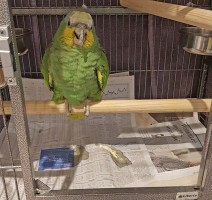
A clearly sick parrot - fluffed-up, crouched, wet droppings, sleepy - but why?
Thus is it is of paramount importance for the owner to get to know the subtleties of their bird’s normal behaviour – how it perches and feeds, how and when it vocalises or preens, what its droppings look like, and how it interacts with other birds or the owner. Any change to the ‘norm’ is often the first sign of trouble, but such changes may be slight, and need regular observation.
The next stage for the vigilant and caring owner is to enlist the services of an experienced avian veterinarian. Veterinary University education is an intensive course packed with detailed information on a whole range of species – we are not like human doctors, dealing just with Homo sapiens! We are expected to deal with anything from a hamster to an elephant and everything in between. Obviously the five or six years devoted to the training course cannot possibly encompass every detail of every disease in all species, so emphasis is given to the economically important groups – horses, cattle, pigs, sheep and goats, and dogs and cats. Smaller companion animals (rabbits, guinea pigs, hamsters) receive reasonable attention, but zoo animals, exotic pets (reptiles, insects, unusual small mammals), and birds other than commercial poultry receive only superficial attention. The situation has improved to a degree in recent years – there are more new graduates coming out with some interest in birds. There are now also post-graduate degrees available in avian and exotic veterinary medicine. But that is the key – interest in avian medicine and bird-keeping.
Let me introduce a few definitions. Disease or Illness is any process that alters the bird’s normal state of health, making it feel unwell. An infection is a disease caused by an infectious agent or germ. Contagious means that the germ can be spread from animal to animal, thus disseminating the disease. Chronic means long-standing, while acute is rapid or sudden. Most of my clients as well as a good many veterinarians look upon any illness in a parrot as the result of an infection, and therefore request (the client) or prescribe (the vet) antibiotics. Probably only about one-third of the disease conditions we see in clinical avian practice are in fact infectious. The rest will be caused by diet, environment, genetics, accident, tumours, hormones, accident or aggression, toxins, etc… Of the infectious agents, some may be viruses, protozoa, or larger parasites. The rest will be bacteria, and it is only this group therefore (about 25% of all cases seen) that will respond to treatment with antibiotics. (See also Bacterial Cultures for Disease Diagnosis)
Chronic effects in the bird’s body by such things as poor diet or environment may well accumulate to produce an acute crisis, which may involve secondary bacterial infection because of the bird’s weakened immune system. This part of the disease may require antibiotics, but the underlying causes also have to be identified and addressed.
Sub-clinical disease is a condition that festers inside the bird without demonstrating overt clinical signs. Such long-term problems may result in poor or non-existent breeding performance; delayed, prolonged, or no feather moult, or feather-plucking; kidney or liver failure; or premature death.
Symptoms are subjective feelings that can be described by the patient. Thus a human can have ‘a stabbing pain’, a ‘buzzing in the ears’, a ‘feeling of nausea’, a pain like a ‘tight band around the head’. Birds cannot describe what they feel: they can only show objective signs, such as lameness, vomiting, scratching etc to be observed by the owner or veterinarian.
Because birds have the aforementioned ability to mask signs of disease until it is almost too late, further valuable time can be lost by the ‘try this antibiotic and see if it works’ approach. Precise diagnosis from the word go is much more valuable, and this is where the veterinarian’s expertise comes in. All veterinary students are taught the value of ‘history taking’ – the process of questioning the owner about the animal and its presenting problem. We are not doctors dealing with a human patient who can answer directly questions about how he or she is feeling. We have to play detective and gather many clues from various sources, part of which would be background history and owner information. A case of sudden onset of feather-plucking in a Cockatoo was diagnosed pretty much by the questioning of the owner as to what had changed, and was proven by the bird’s response to the replacement of a picture that had been moved.
The background history will include such information as the species, age and sex of the bird. How long has it been owned and where did it come from? How is it housed and what food is it given? All of these factors can influence the type of disease occurring. Recently imported birds, or those acquired from pet shops, dealers, or at a bird show, may show illness resulting from stress and contagious infections; while those acquired quietly from a private source or bred yourself should be reasonably healthy. If from a pet-store, have any diagnostic tests already been carried out, such as psittacosis, DNA sexing, or PBFD (Psittacine Beak and Feather Disease)? A recently acquired bird may have problems with settling in, resulting in stress-related conditions, while a bird that you have had for 30 years could be suffering from chronic deficiency disease or environmental factors such as smoke.
How old is the bird? Just as human babies and children will show a different range of problems to the doctor than do adults and pensioners, so young birds will suffer from conditions that are unlikely to afflict an old bird, and vice versa. Good examples are PBFD virus in young African grey parrots, or arthritis in old parrots. In many cases the age of the bird is known because of a provided hatch date, or a year suffix on a leg ring, but very often this knowledge is not available, and then we have to estimate how old the patient is. Differences in plumage, eye colour, or beak shape associated with age are discussed elsewhere.
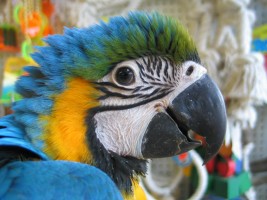
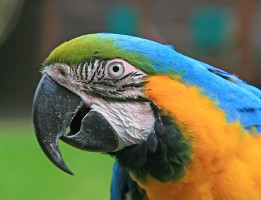
Blue & Gold Macaws. Left - juvenile has rounded head, smaller maxillary beak, grey iris;
Right - adult has flatter head, larger maxillary beak, yellow iris
The sex of the parrot is obviously important, but diseases associated with sex and breeding are covered separately.
Next we would need to discuss the bird’s DIET. So many of the problems we see are related to diet in some way – unbalanced, deficient in important items, too high in fat, too much, too little, poor quality, containing toxic items, or just completely wrong for the bird! Nutritional requirements and the feeding of parrots are covered elsewhere - Parrot Nutrition. The food can be responsible for making a bird actively sick; or weakening its immune system so that it is vulnerable to infection; or resulting in chronic disease from the lack of various essential nutrients.
The last thing we do always when we go to the dentist is to clean our teeth. Similarly, owners like to clean their bird’s cage before they take it to the vet, so that we do not think they are neglecting their pet or keeping it in squalid conditions. I ask my clients not to do this, because it can get rid of important diagnostic clues. I will question the owner about the food that is fed, and they may list a whole range of ‘good’ items presented to the bird, but when one looks at the cage it is clear that he is dumping most of these items on the floor, and just selecting the stuff he likes. Similarly, we can see how much or how little the bird may be eating out of what is presented, and also look for signs of vomiting, bleeding, or discharges.
The basic quality of the food is important: seed-based mixes come in varying prices, according to their constituents, and the efficiency of the cleaning process. Once it is purchased, storage is important. Contamination with dust, mould, or rodent urine and droppings will all potentially cause ill health in your birds. The same applies to quality of drinking water. Fresh water should be available at all times, and we all know that birds will dunk food, droppings, and bedding material in their water, producing a thick soup of disease-forming organisms, especially in hot weather.
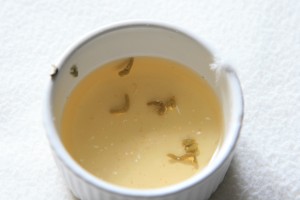
Water bowl contaminated with bird droppings
Having discussed what goes in at the front end of the bird, we now turn our attention to what comes out at the back. Birds and reptiles pass a combined ‘dropping’ which is a mixture of waste products from the kidneys and the bowel. The kidney waste is primarily urate, a semi-solid white substance, together with some true liquid urine. The material passed from the gut after digestion is mixed with this as a coil of brown, green, or black material. The relative proportions of these components will vary with species, diet, time of day, and breeding cycle. Small seed eaters pass a small, dry, black and white dropping; nectar feeders pass very fluid droppings. The first dropping of the day is usually bulky and sloppy, as is that passed by an egg-laying hen. Food pigments may colour either the urate or the faecal part – blackberries, beetroot, and chillies for example. A bird that is stressed will pass a very liquid dropping.
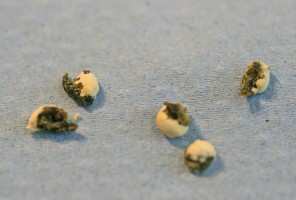
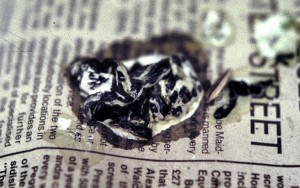
Left - budgerigar droppings with green/brown faecal component, creamy urates, no liquid.
Right - normal parrot dropping, with black faeces, white urate, some liquid urine
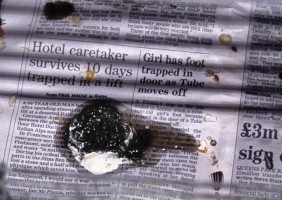
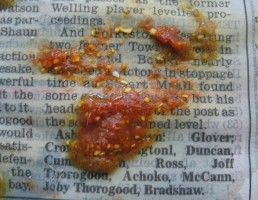
Left - bulky, sloppy dropping by parrot first thing in the morning.
Right - parrot eaten chilli peppers - dropping stained red and containing undigested seeds
So there is considerable variation in appearance of droppings that could still be considered as normal. Once again, we need to know what is normal before we can diagnose the abnormal. Another situation where the cage or carry box can provide clues! However, we do look closely for signs of soft, pale faecal material – indicating a bowel dysfunction, possibly enteritis. Very bulky, pasty faeces can be a sign of pancreatic or liver disease. Urates that should be white but instead are yellow or green indicate liver or kidney damage; an increase in liquid urine in a previously drier dropping may be a sign of diabetes or kidney disease. Undigested food items coming straight through would suggest serious bowel dysfunction, while blood may indicate acute infection, foreign body, ulcer or tumour, egg-related problems, or heavy metal poisoning. Passage of roundworms or tapeworms needs no explanation! All these are grossly visible at the time of examination, but can give us vital clues as to which direction to proceed diagnostically. The droppings may be examined in more detail in the laboratory, but at least we have some early signs.
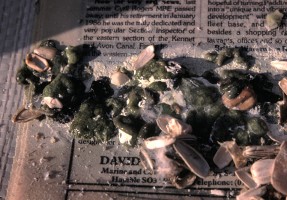
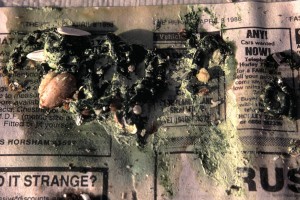
Left - diarrhoea: sloppy green faeces, but normal white urate
Right - normal dark-green faeces, green-tinged, excessive urates, more urine

Polyuria - excessive urine production - in this case the parrot has diabetes
OK, so we have come a long way by asking all these questions about the bird and its diet and husbandry, and during this time the experienced veterinarian should also be watching the bird. These several minutes will have given it time to relax, and it may then show signs that were hidden when it first came in because it was stressed and excited. Owners always want to plonk their birds on the table and immediately get them out to show the vet, but I insist on this preliminary period to allow the bird to calm down. Then we can see it beginning to fluff its feathers and close its eyes; scratch itself or over-preen repeatedly; breathe heavily with tail bobbing; attempt to vomit; hold its leg up; or even fall off the perch! It is also a good reason to justify the added time and expense of a house-call to see the bird in its own home environment: we can pick up much more information then as to how the bird is being kept. This is especially useful when dealing with behavioural problems.
At this stage of the proceedings, the experienced veterinarian should have a good idea of what is going on with the bird, and will then decide what further diagnostic tests and possible treatments may be required. It is now that the patient will be handled! The catching and handling of the bird is an important skill that can make or break a vet’s reputation with birds. Quiet confidence and ability will reduce the stress for all concerned.
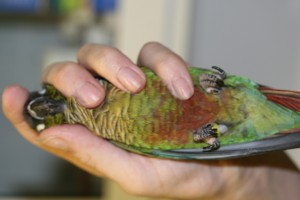
Green-cheeked Conure 'Freddie' held securely and comfortably for examination
The handling period should be kept to a minimum, especially if respiratory distress has already been noted. Everything that may be needed – sampling instruments, injections – should be ready to hand. The bird certainly should not be held for many minutes, while waving the hand and bird up and down to emphasise a point to the owner, especially if the bird is suffering from breathing problems! This actually happened on one TV Vet programme, and of course the unfortunate cockatiel died. There is no doubt that modern techniques of diagnostic imaging etc all have their place in precise diagnosis, but they should not be used on every case just because they are in the practice. Common sense and basic handling, coupled with a thorough history should give a diagnosis in at least 50% of cases.
A long explanation about something that can take place in 15 or 20 minutes in the clinic! I hope I have managed to convey something of the wealth of information that is required from the owner and has to be investigated by the vet in order to make a diagnosis of the numerous possible disease conditions that can afflict our birds. It is only by early detection and correct diagnosis that we can provide the right treatment and hopefully cure the bird. However, as I always say, we are dealing with biological grey all the time – there is no cut and dried black or white. The same condition can affect two different birds, and one may live while the other dies. Multiple problems can occur in one individual, all adding to the joy and frustration of bird-keeping and veterinary practice!
A separate article will deal with some of the common types of illness in birds. (Common Diseases of Parrots)
This article was adapted, with permission, from "Keeping Parrots - Understanding Their Care & Breeding" by Alan K Jones BVetMed MRCVS
The Crowood Press, ISBN 978 1 84797 263 7 (2011)
Posted AKJ October 2020
